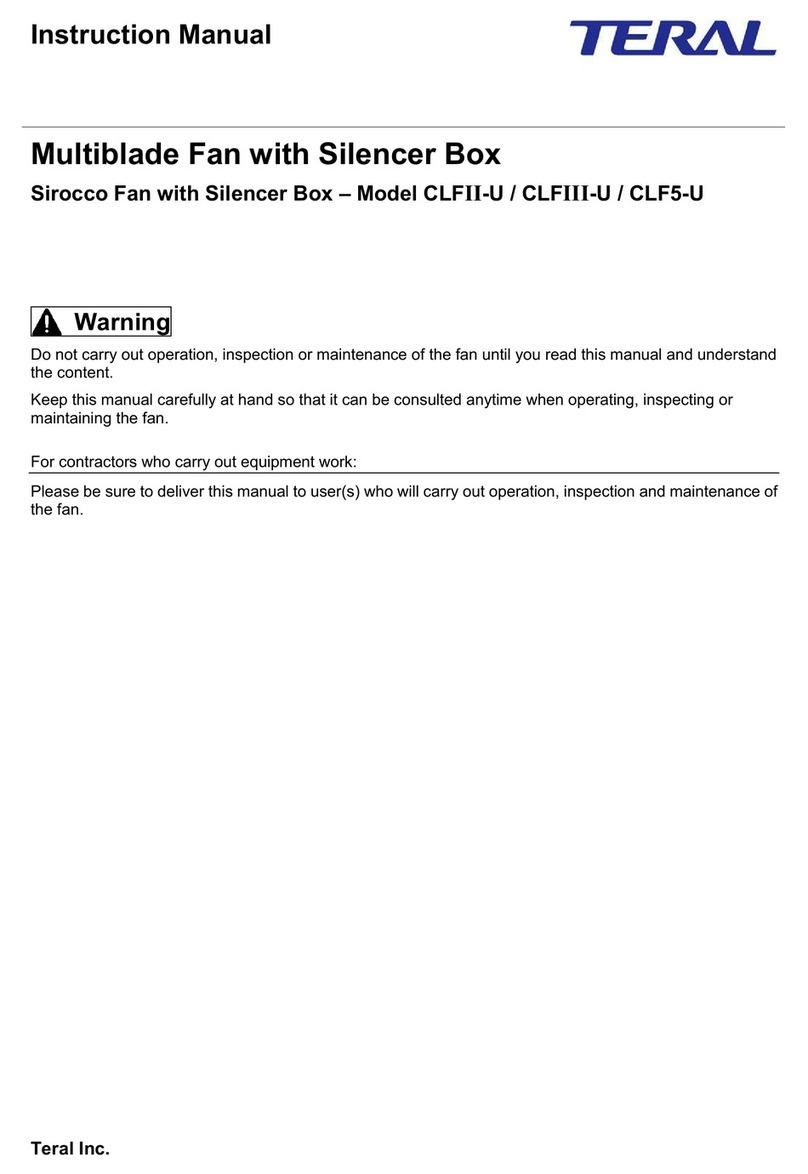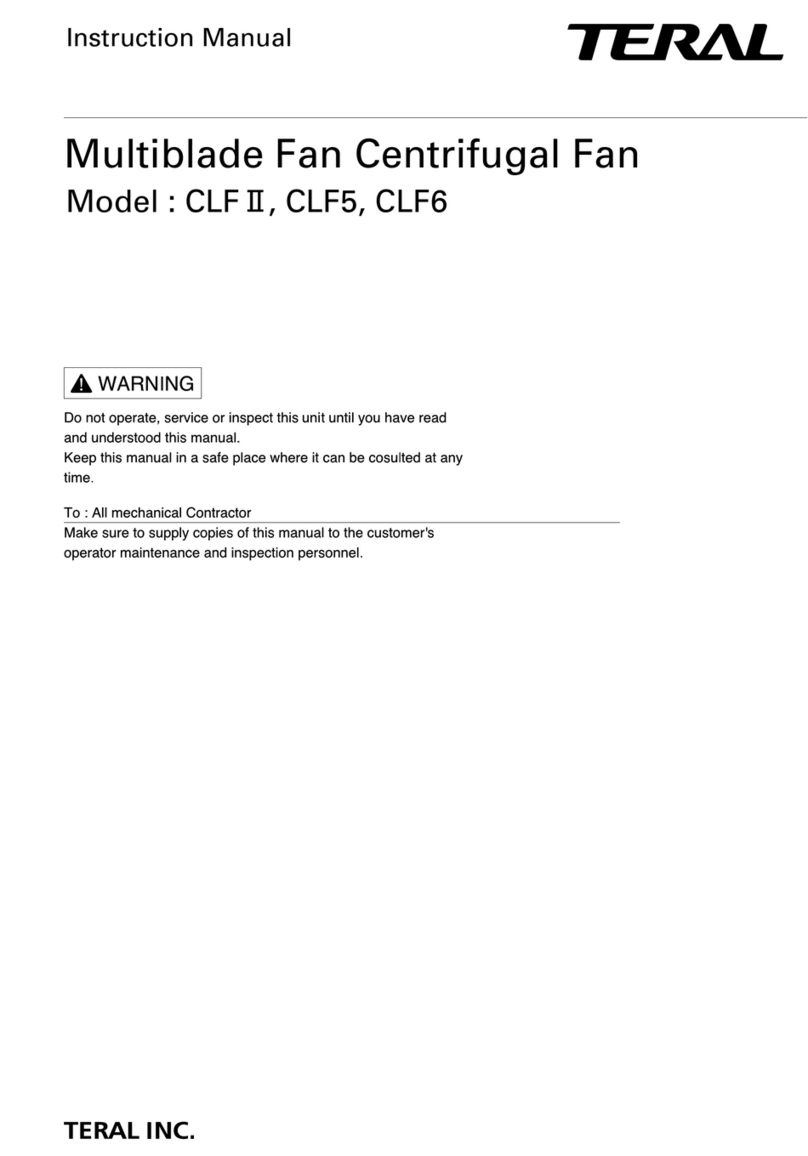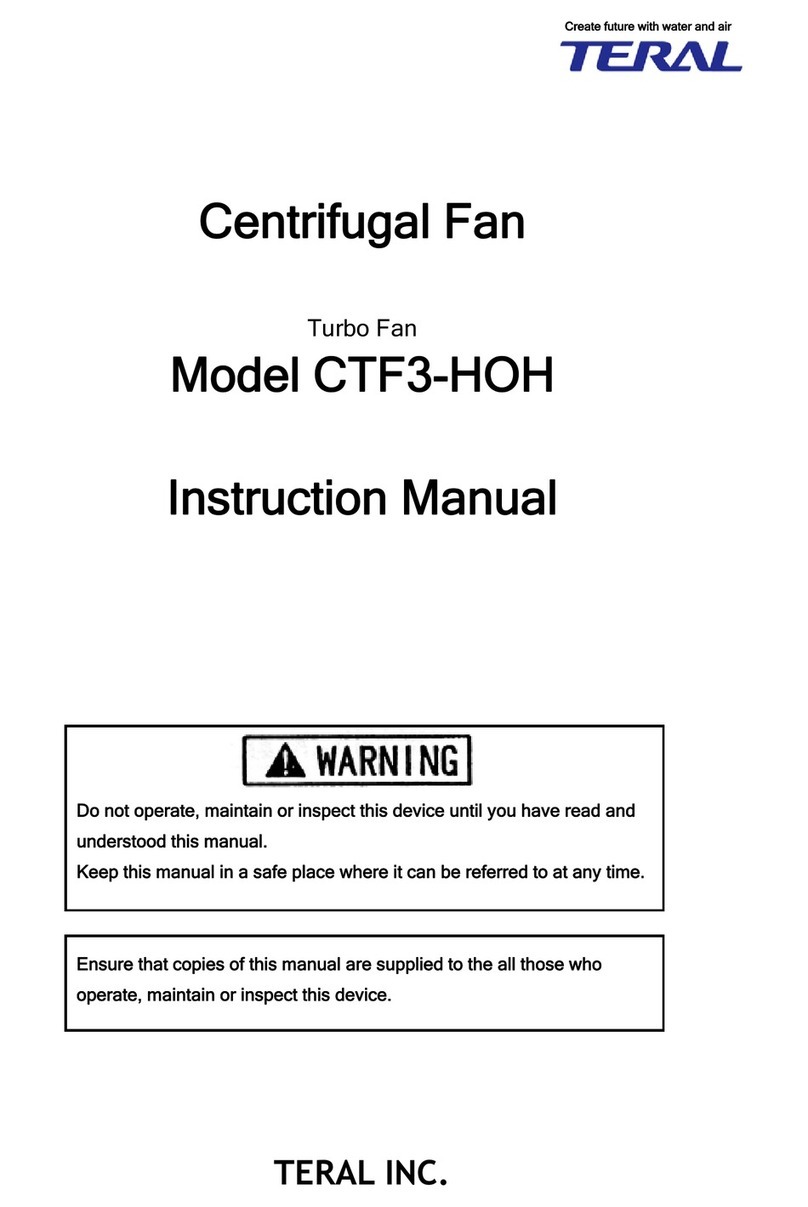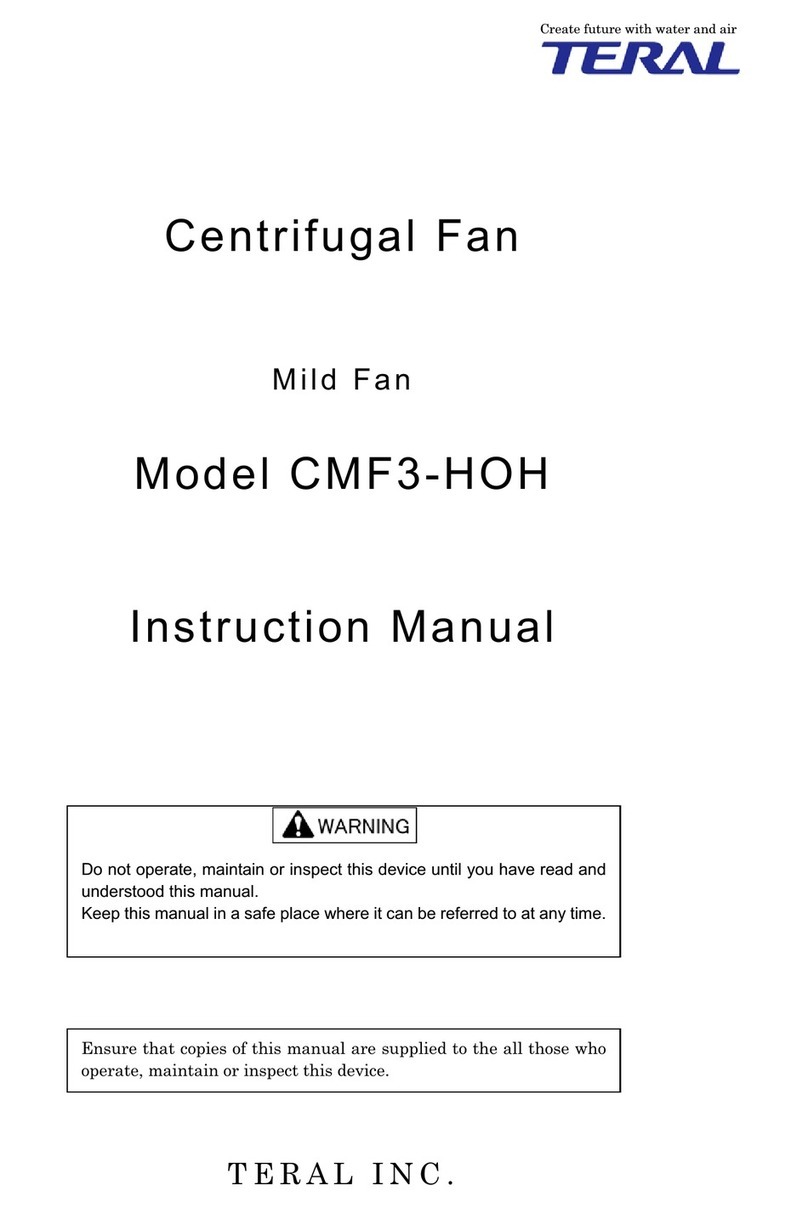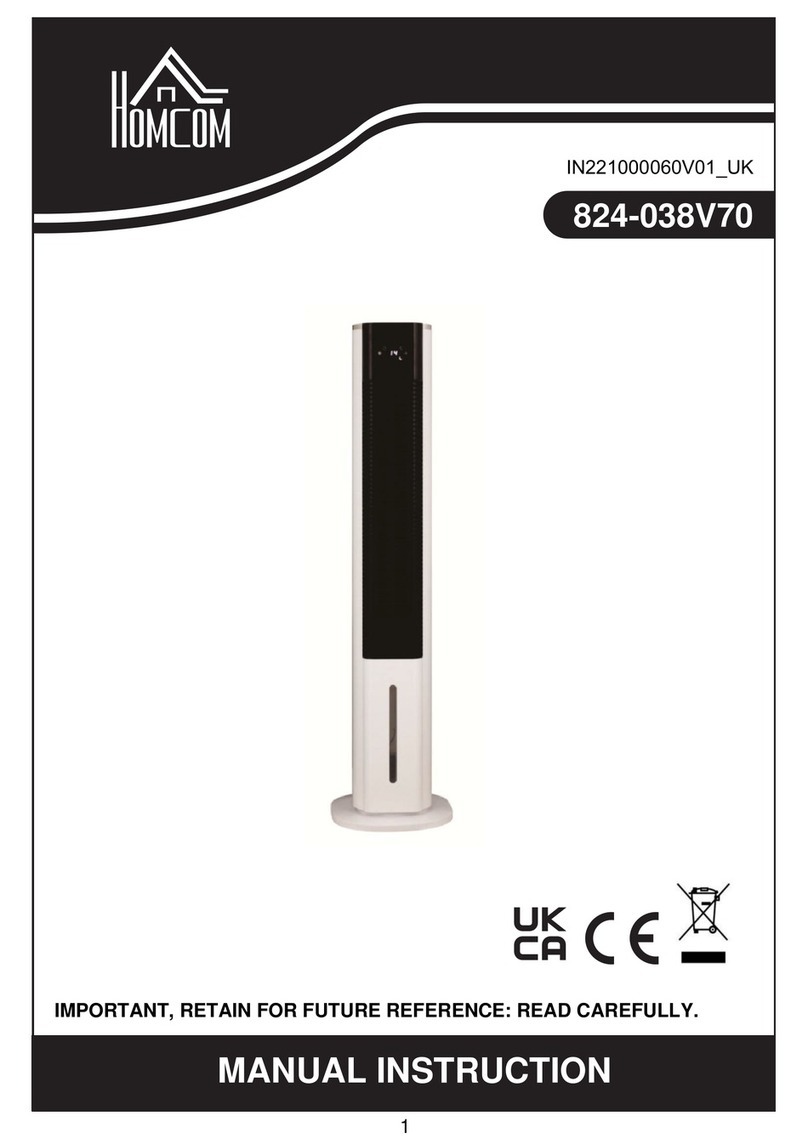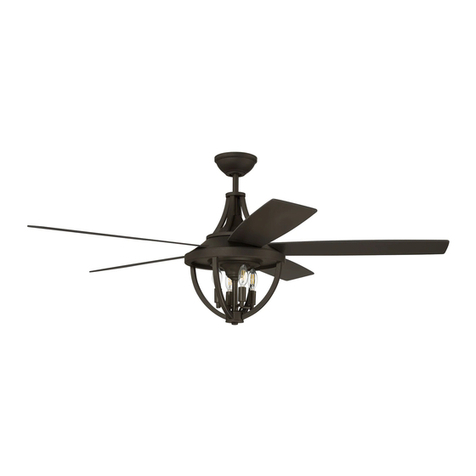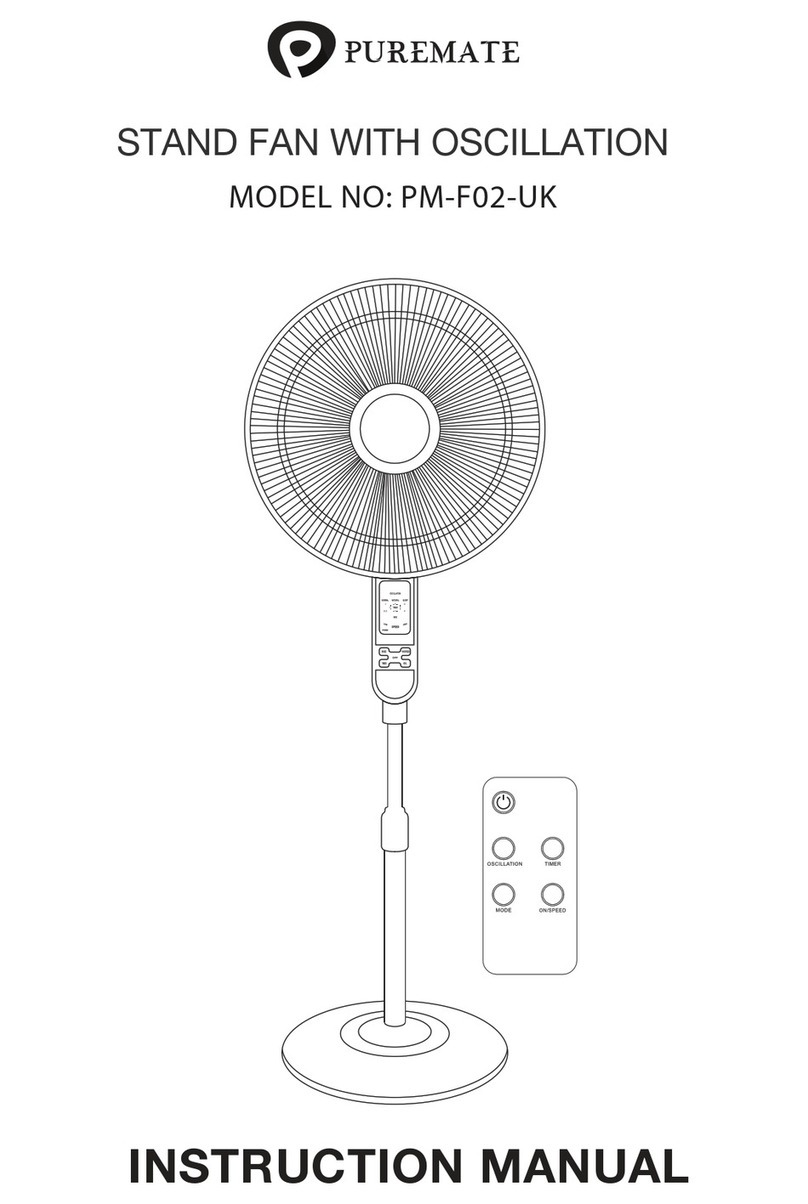Teral LCF Series User manual

TERAL INC.
Instruction Manual
Line Sirocco Fan
Model: LCF
Warning
Do not carry out operation, inspection or maintenance of the pump until you read this manual and
understand the content.
Keep this manual carefully at hand so that it can be consulted at anytime when operating, inspecting or
maintaining the fan.
For contractors who carry out equipment work:
Please be sure to deliver this manual to the customer who will operate, inspect or maintain the fan.

I
Limited warranties
1. In the event of a failure or breakage under proper use of the product during the warranty period,
equipment supplied by Teral Inc. shall be repaired or replaced free of charge within the scope of
the relevant part, provided that such failure or breakage is attributable to inadequacy of the design
or workmanship of the equipment.
2. The warranty mentioned in the above clause shall be only the mechanical warranty of the defective
part, and shall not cover any expenses or other damage arising from the failure or breakage.
3. In the event of the following failures and breakage, the costs of the repairs shall be borne by the
user.
(1) Failures and breakage attributable to equipment that was not delivered by Teral Inc.
(2) Failures and breakage after the expiration of the warranty period
(3) Failures and breakage caused by disasters or force majeure, such as fire, acts of God or
earthquakes
(4) Failures and breakage resulting from repairs or modifications made without the consent of
Teral Inc.
(5) Failures and breakage when parts other than those specified by Teral Inc. are used
4. Teral Inc. shall not be liable for any damage caused by incorrect or reckless use of the fan. Cost
and expenses incurred for sending engineer(s) in such a case shall be borne by the user.
5. If the cause of the failure is unclear, necessary actions shall be determined through mutual
consultation.

II
Purpose of this manual
The purpose of this manual is to provide the user with detailed information necessary to properly
operate, maintain and inspect the fan.
This manual contains the following information and has been prepared to assist the persons
experienced in the operation of fans, or those who have been trained by such experienced operators.
Only qualified personnel such as licensed electrical engineers are allowed to carry out the electrical
wiring work.
Contents
Page
Limited warranties........................................................................................................................................... I
Purpose of this manual.................................................................................................................................. II
Contents ........................................................................................................................................................ II
1. Safety precautions............................................................................................................................... 1-1
1.1 Safety indications and their meanings ...........................................................................................1-1
1.2 Safety precautions ......................................................................................................................... 1-1
1.2.1 Precautions for installation ·····················································································1-1
1.2.2 Precautions for operation·······················································································1-2
1.2.3 Precautions for maintenance and inspection ······························································1-2
1.3 Location of the warning labels ....................................................................................................... 1-2
2. Configuration and overview of the fan................................................................................................. 2-1
2.1 Structure and part names of the fan .............................................................................................. 2-1
2.2 Specifications and accessories of the fan...................................................................................... 2-2
3. Installation ........................................................................................................................................... 3-1
3.1 Before using the fan....................................................................................................................... 3-1
3.2 Precautions for storage.................................................................................................................. 3-1
3.3 Precautions for the location of installation ..................................................................................... 3-1
3.4 Installation ...................................................................................................................................... 3-1
3.5 Precautions for connecting the duct .............................................................................................. 3-2
3.6 Precautions for wiring work............................................................................................................ 3-3
3.7 Wiring method................................................................................................................................ 3-4
4. Preparation for operation..................................................................................................................... 4-1
4.1 Points to be checked before test operation ................................................................................... 4-1
4.1.1 Electrical system··································································································4-1
4.1.2 Check items related to the fan·················································································4-1
5. Operation............................................................................................................................................. 5-1
5.1 Precautions for starting the fan...................................................................................................... 5-1
5.2 Precautions during the operation................................................................................................... 5-1
5.3 Precautions for long-term shutdown ..............................................................................................5-1
6. Maintenance and inspection................................................................................................................ 6-1
6.1 Daily inspection.............................................................................................................................. 6-1
6.2 Periodic inspection......................................................................................................................... 6-1
7. Troubleshooting................................................................................................................................... 7-1
7.1 Troubleshooting ............................................................................................................................. 7-1

1-1
1. Safety precautions
1.1 Safety indications and their meanings
This instruction manual divides precautions into the following four categories according to the level
of hazards (or the severity of the accident).
Be sure to understand the meanings of the following terms and comply with the content
(instructions) of the instruction manual.
Indications Meaning
Danger
Indicates an imminently hazardous situation. Failure to observe the
procedures or instructions will result in death or serious injury.
Warning
Indicates a potentially hazardous situation. Failure to observe the procedures
or instructions may result in death or serious injury.
Caution
Indicates a potentially hazardous situation. Failure to observe the procedures
or instructions will result in minor or moderate injury or cause damage to
equipment or devices.
Note Indicates information that is in particular to be noted or emphasized.
1.2 Safety precautions
1.2.1 Precautions for installation
(1) Securely install the fan according to the instruction manual.
(2) Select a location strong enough to support the main unit, and securely install the fan there.
Otherwise, the fan may fall and cause injury.
(3) Do not install the fan anywhere exposed to direct flame or with any other risk of high temperature.
Otherwise, it may lead to a fire.
(4) Do not install the fan anywhere exposed to the rain such as outdoors or in a humid place such as
a bath facility (humidity of 85% or higher). Otherwise, it may lead to an electric shock or a fire.
(5) Do not use the fan for venting from a humid place such as a bath facility (humidity of 85% or
higher).
(6) Do not install the fan in a location where explosive dust or gases are produced or where
hazardous or corrosive gases are produced from acids, alkalis, organic solvent, paint or other
substances. Otherwise, it may lead to an explosion or a fire.
(7) Install the open air intake at a position far away from the exhaust vents of combustion gas and
other gases.
(8) When a room is fitted with a combustion appliance with a chimney and the fan is used for
discharging the flue gas from the room, you must install an air intake port that is large enough to
prevent the flow of the flue gas back into the room.
Otherwise, it may lead to carbon monoxide poisoning.
(9) When a wooden construction is covered with metal lath, wire lath, or metal sheet and is
penetrated by the fan and the metal duct connected to the fan, install the fan and the metal duct in
such a way that they are not electrically in contact with the metal lath, wire lath, or metal sheet.
Otherwise, it may lead to ignition in the event of an electric leak.
(10) Only qualified personnel such as licensed electrical engineers are allowed to carry out the
electrical wiring work. Before carrying out any wiring work, be sure to turn off the main power.
(11) Be sure to install a ground fault interrupter to the main power source.
(12) Do not forcibly bend, pull, or pinch the power cable.
Otherwise, it may lead to an electric shock.
(13) Do not expose the fan to water.
If the fan gets wet, the resulting short circuit and/or insulation degradation of the electric circuit
may damage it.
(14) Install a protective wire mesh etc. to the open air intake.

1-2
1.2.2 Precautions for operation
(1) Ensure to use the fan at the rated voltage and frequency.
(2) When the fan is running, do not touch any parts of the unit other than those required for operation.
(3) Do not put your fingers or any rods into the air intake or blowout port.
(4) Do not place any objects around the air intake or blowout port of the fan.
(5) Do not run the fan with tools or other objects placed on the fan.
(6) Do not run the fan if there are any defects or faulty parts.
(7) Never touch the fan while the power is on even if the fan is stopped.
The fan may suddenly start running and lead to injury. It may also lead to an electric shock.
1.2.3 Precautions for maintenance and inspection
(1) Maintenance and inspection must only be carried out by personnel who have been trained to
handle the fan.
(2) Before carrying out maintenance or inspection, ensure that all the relevant workers are informed
of the operation accordingly.
(3) Before carrying out maintenance or inspection, be sure to stop the fan and turn off the main power
on the operation panel. Otherwise, you may suffer an electric shock and/or get injured by an
unexpected action of the fan during the work.
(4) If you need to relocate, repair, or modify the fan, ask Teral Inc. or the service center specified by
the manufacturer.
1.3 Location of the warning labels
Warning labels are affixed to the locations as below figure. If these labels get dirty and hard to read
or if they are peeled off, replace them with a new one.
Warning
Observe all the safety instructions affixed to the machine as well as
those described in this instruction manual.
Label dNameplate
Label c
Label c
Warning
Improper wiring may lead to an electric leak and a fire.
Caution
○◦Ask the vendor to carry out installation,
electrical work, and repairs.
○Only the personnel authorized by the
person in charge of machine management
are allowed to carry out the operation and
inspection.
○Read the instruction manual thoroughly,
and follow the instructions.
Label d

2-1
2. Configuration and overview of the fan
2.1 Structure and part names of the fan
(1) Low noise type: 18LCF2-40S, -50S; 20LCF2-65S; 22LCF2-90S, -100S, -100;
25LCF2-120S, -150S, -180
8 4
5
6
1
3
7
9
10
2
(2) Silent type: 18LCF2-40SU, -50SU; 20LCF2-65SU; 22LCF2-90SU, -100SU, -100U
25LCF2-120SU, -150SU, -180U
8
11
4
5
6
1
3
7
9
10
2
No. Part name No. Part name
{
1Casing {
7Inspection opening
{
2 Impeller {
8Companion suction flange
{
3 Motor {
9Companion discharge flange
{
4 Terminal block {
10
Suspension lug
{
5 Earth terminal {
11
Silencer
{
6 Terminal block cover

2-2
2.2 Specifications and accessories of the fan
If you have purchased our standard product, refer to the “Standard specifications” table.
Also for a custom-made product with special specifications, refer to the specifications including the
external dimensions drawing.
Caution
Do not use the fan under any conditions other than those provided in the
specifications. Otherwise, it may lead to an electric shock, a fire, or
failures.
(1) Standard specifications
Clean air
Applicable gas Temperature: 0°C to 40°C (Humidity: 85% or less )
Installation location Indoors (at ambient temperature of 0°C to 40°C)
Installation method To be installed on the ceiling
Type Totally closed type
18LCF2-40S, -40SU・・・・・・・ 50Hz, 60Hz Single-phase 100V
18LCF2-50S, -50SU・・・・・・・ 50Hz, 60Hz Single-phase 100V
20LCF2-65S, -65SU・・・・・・・ 50Hz, 60Hz Single-phase 100V
22LCF2-90S, -90SU・・・・・・・ 50Hz, 60Hz Single-phase 100V
22LCF2-100S, -100SU ・・・・ 50Hz, 60Hz Single-phase 100V
22LCF2-100, -100U ・・・・・・・ 50Hz, 60Hz Three-phase 200V
25LCF2-120S, -120SU ・・・・ 50Hz, 60Hz Single-phase 100V
25LCF2-150S, -150SU ・・・・ 50Hz, 60Hz Single-phase 100V
Standard specifications
Motor
Phase, voltage
25LCF2-180, -180U ・・・・・・・ 50Hz, 60Hz Three-phase 200V
(2) Standard and special accessories
Standard accessories Special accessories
Companion flange Dedicated control switch
Silencer (only for the silent types) Vibration absorber for ceiling suspension hanger

3-1
3. Installation
3.1 Before using the fan
When you receive the fan, check the following points first.
If there are any problems, contact the vendor from which you purchased the product.
(1) Check the nameplate to verify that the delivered product is exactly what you ordered.
(2) Check that no part of the product is damaged during transportation.
(3) Check all the fastening parts including bolts and nuts are securely tightened.
(4) Check all the accessories that you ordered have been completely delivered.
3.2 Precautions for storage
(1) Be careful not to allow rust to be formed on the product during the storage period until it is
installed.
In particular, take measures to prevent rainwater or dust from entering the inside, for example by
covering the fan with a tarpaulin.
(2) Store the fan indoors.
Ensure to protect the connections for power supply or other parts against moisture.
3.3 Precautions for the location of installation
Install the fan at a location where the following conditions are satisfied:
(1) This fan is designed only for indoor use. Install it at a location not exposed to the wind or rain.
Ensure that the fan does not suck in any rainwater.
(2) A dry, well-ventilated environment, which as free of dust and moisture.
(3) A location with an ambient temperature of 0°C to 40°C.
(4) Do not run the fan at a temperature and humidity of intake air that may cause condensation
inside the machine on site.
(5) A location that allows easy and safe work upon maintenance or repairs of the fan.
When the fan is mounted on a ceiling, ensure to provide an inspection opening of 45 cm square
or larger for maintenance and inspection work.
3.4 Installation
Warning
Ask the vendor to install the fan in consideration of its center of gravity
and its weight.
Caution
Wear gloves when installing the fan.
Otherwise, you may be injured with burrs on a cut edge.
(1) After checking the direction of the flow, horizontally suspend the fan using the hanging bolts
embedded into the ceiling in advance. Ensure that the load of the unit is evenly distributed among
all the bolts.

3-2
(2) Ensure that the hanging bolts are strong enough to sustain the load (in terms of the strength of
the bolt itself as well as the embedded condition).
(3) After the fan is installed, lock the nuts on the hanging bolts to prevent them from coming loose.
3.5 Precautions for connecting the duct
Caution
Ensure that the weight of the duct is not applied to the fan.
Otherwise, it may lead to malfunctions, damage, or vibration.
(1) Connect the duct to the flange of the fan through taping or expansion joints, and provide support
to the duct.
(2) Before connecting the duct, check the inside of the duct and fan and remove any foreign objects
such as waste cloth and tools.
Warning
If the air intake of the fan is opened, be sure to install a protective wire
mesh on it.
(3) To prevent foreign matter from being sucked in, install a protective wire mesh at the duct inlet or
the air intake of fan where atmospheric air is directly sucked. If dust or waterdrops are expected
to get into the fan, be sure to install a filter to block the entry.
Caution
Install the duct so that it makes a downward slope toward the outdoor
side.
(4) If the slope of the duct is insufficient, the rainwater may get into the room and get the household
goods or other items wet. It is recommended to install a (commercially available) weather cover
outdoors.
(5) Do not run the duct in the following ways. Such duct work may cause insufficient flow rate and/or
abnormal noise.
■Sharp bends ■Many bends ■Bends near the blowout
or air intake port ■Restriction of flow
Double nuts

3-3
3.6 Precautions for wiring work
Warning
• Use high-quality wiring equipment and devices, and carry out wiring
work safely and securely according to the technical standards for
electrical facilities, as well as the indoor wiring regulations.
• Only qualified personnel such as licensed electrical engineers are
allowed to carry out electrical wiring work. Incomplete wiring work by
unqualified persons is prohibited by law.
• Do not forcibly bend, pull, or pinch the power cable. Otherwise, it may
lead to an electric shock.
(1) Be sure to install a ground fault interrupter on the primary power side of the fan.
(2) To prevent burnout of the motor and to protect the circuit, be sure to install an electromagnetic
switch fitted with a thermal relay on the wiring of the motor. Use a thermal relay of manual reset
type instead of automatic reset type.
On selecting the thermal relay, refer to the catalog, as a guide, for the electric current value at the
maximum flow rate.
(3) Be sure to connect a ground wire to prevent an electric shock.
Do not connect the ground wire of the fan to the ground wire of a gas pipe, water pipe, lightening
rod, or telephone line.
Warning
Incomplete grounding work is prohibited by law and is extremely
dangerous.
(4) Connect the power wires according to the wiring diagram in the next section “3.7 Wiring method.”
(5) Control the fluctuation of the voltage within ±10% of the rated voltage, and the frequency within
±5% of the rated frequency. Keep in mind that if you use the fan at a voltage or frequency out of
the range, the fan may break down.
(6) Before running the fan, check the following points again:
cAn appropriate fuse (breaker) is installed.
dWiring is correct.
Warning
Improper wiring may lead to an electric leak and a fire.
eThe fan is securely grounded.
fDepending on the product model, your fan needs either single-phase 100V power or
three-phase 200V power. Connect your fan to the correct power source.
gFor a three-phase powered model, ensure that none of the three wires of the motor is loose or
disconnected.
Caution
Do not run a three-phase powered model with only two power wires
connected. Otherwise, it may cause the motor to burn out.

3-4
3.7 Wiring method
Connect the wires according to the following diagrams. The lines indicated by dashed lines in the
diagram should be arranged and connected by the customer.
(1) 18LCF2-40S, -40SU 18LCF2-50S, -50SU
20LCF2-65S, -65SU 22LCF2-90S, -90SU
22LCF2-100S, -100SU 25LCF2-120S, -120SU
25LCF2-150S, -150SU
<Run mode: High> <Run mode: Low>
(2) 22LCF2-100, -100U
<Run mode: High>
<Run mode: Low>
(3) 25LCF2-180, -180U
Moto
r
White
Capacitor
Brown
Green/Yellow
(Striped cable)
Red
Terminal
block
Power source
Single-phase 100V
Black
White
Moto
r
Green/Yellow
(Striped cable)
Brown
Terminal
block
Power source
Three-phase 200V
Black
White
Moto
r
Terminal
block
Power source
Three-phase 200V
Green/Yellow
(Striped cable)
Red
Black
White
Brown
Blue
Y
ello
w
Moto
r
Terminal
block
Power source
Three-phase 200V
Green/Yellow
(Striped cable)
Red
Black
White
Brown
Blue
Y
ello
w
Moto
r
White
Capacitor
Brown
Green/Yellow
(Striped cable)
Red
Terminal
Block
Power source
Single-phase 100V
Black
White

4-1
4. Preparation for operation
4.1 Points to be checked before test operation
4.1.1 Electrical system
(1) Check if the fan is correctly wired.
(2) Check if the terminals are securely connected.
(3) Check if the fan is securely grounded.
4.1.2 Check items related to the fan
(1) Check that no water has accumulated in the fan and that no foreign objects or materials such as
tools have been left inside.
(2) Check that all the connections at the hanging bolts, the main unit of the fan, accessories, duct,
and other parts are securely tightened.
Warning
Always turn off the main power of the fan, before turning the fan rotor by
hand to check the status.
(3) Before connecting the duct, turn the fan rotor by hand to check if it rotates smoothly without any
signs of internal failures.
(4) Post an operator in advance so that the fan can be turned off immediately at the supervisor’s
instruction.
Warning
Do not operate the fan if you notice any abnormal condition such as
noise. Be sure to contact the vendor or the service provider specified by
the manufacturer.

5-1
5. Operation
5.1 Precautions for starting the fan
(1) Turn on and off the power switch once or twice to check that the fan runs without any problems
such as abnormal noise or vibrations. At that time, also check the direction of rotation.
If a three-phase powered fan rotates reversely, swap two of the three power wires.
Warning
Be sure to turn off the main power before changing the wiring of the fan.
Otherwise, it may lead to an electric shock.
(2) Turn on the power and watch the unit until it reaches full speed.
Check for any vibrations and noise at each section of the fan.
Also check that the electric current at the motor shows a normal value. Pay special attention to
blowing of cold air because the current value becomes higher in that case compared with blowing
of air at the room temperature.
5.2 Precautions during the operation
Warning
When to stop the fan operation, be sure to turn off the main power.
The fan may start suddenly when power is restored, which expose the
personnel to great danger.
(1) Frequent starting and stopping the fan quickly damages it.
As a guide, limit the startup frequency to about six times or less per hour.
5.3 Precautions for long-term shutdown
(1) Ensure to protect the motor and cable connections against moisture.
(2) Before running the fan after a long period of shutdown, inspect all the parts of the fan.
Warning
If you leave the fan unused for a long time, be sure to turn off the main
power.

6-1
6. Maintenance and inspection
6.1 Daily inspection
(1) Check the fan for any vibration, noise, abnormal current value, or any other abnormal conditions.
A deviation from the normal status is a sign of a failure. Therefore, immediately perform detailed
inspection and maintenance.
For this purpose, it is recommended to keep an operation log.
(2) If strong vibrations occur, stop the operation and check for any improper duct piping, any loose
hanging bolts, any accumulation of dust onto the impeller, or any damage to the bearings.
(3) In addition to vibrations, noise is an important factor in judging the operating condition.
If you hear a metallic sound possibly made by something being in contact with the rotor,
immediately stop the operation.
6.2 Periodic inspection
Warning
Before carrying out the inspection of the fan, be sure to turn off the main
power. The fan may suddenly start up through automatic operation or
from other causes, thus exposing the personnel to great danger.
Perform the periodic inspection at least once a year.
Take care of the following items, in addition to the daily inspection items.
(1) Check each section for any loose bolts or nuts.
(2) Check the impeller, motor, and others parts for any corrosion.
(3) Clean the inside of the fan.
(4) Check that the insulation resistance of the motor has not decreased. The resistance must be at
least 1MΩ.
(5) The motor has an estimated service life of about 20,000 hours. Since the life depends on the
operation conditions, the motor should be replaced If any abnormal vibration or noise is
generated.

7-1
7. Troubleshooting
7.1 Troubleshooting
The cause of the failure and the corrective measures against it may be different even if the fan
exhibits the same symptom. In addition, there may be two or more causes.
If you cannot find the cause or corrective measures in the following table, immediately stop the
operation and contact the vendor or the service center specified by the manufacturer.
Symptom of failure
Cause of failure
Insufficient flow rate
Motor does not run
Excessive noise
Excessive vibration
Motor overload
Remedy
Improper duct piping 999Inspect and repair the duct piping
Excessive duct resistance 999Review the duct piping
Insufficient duct resistance
9
Review the duct piping
Insufficient rotation speed 9
Check the power voltage
Reverse rotation 9
Swap two of the power wires of the
motor
Contact of rotor with
stationary part 9999Disassemble and repair
Contamination with foreign
matter 9999Disassemble and conduct internal
inspection
Faulty bearing
(damaged/worn out)
999Replace the motor
Improper installation 99Check the installation
Failure related to power
supply 9
9Inspect and repair
Failure of the motor 999Replace the motor
Caution
If you need to change any parts or repair the pump, ask the vendor or
the service center specified by the manufacturer.
Improper work may lead to malfunctions or accidents.

Head Office
230, Moriwake, Miyuki-cho, Fukuyama-city, Hiroshima, 720-0003, Japan
Tel.+81-84-955-1111 Fax.+81-84-955-5777
www.teral.net
2016 10
E‑IMN‑00325‑000‑D
This manual suits for next models
18
Table of contents
Other Teral Fan manuals
Popular Fan manuals by other brands
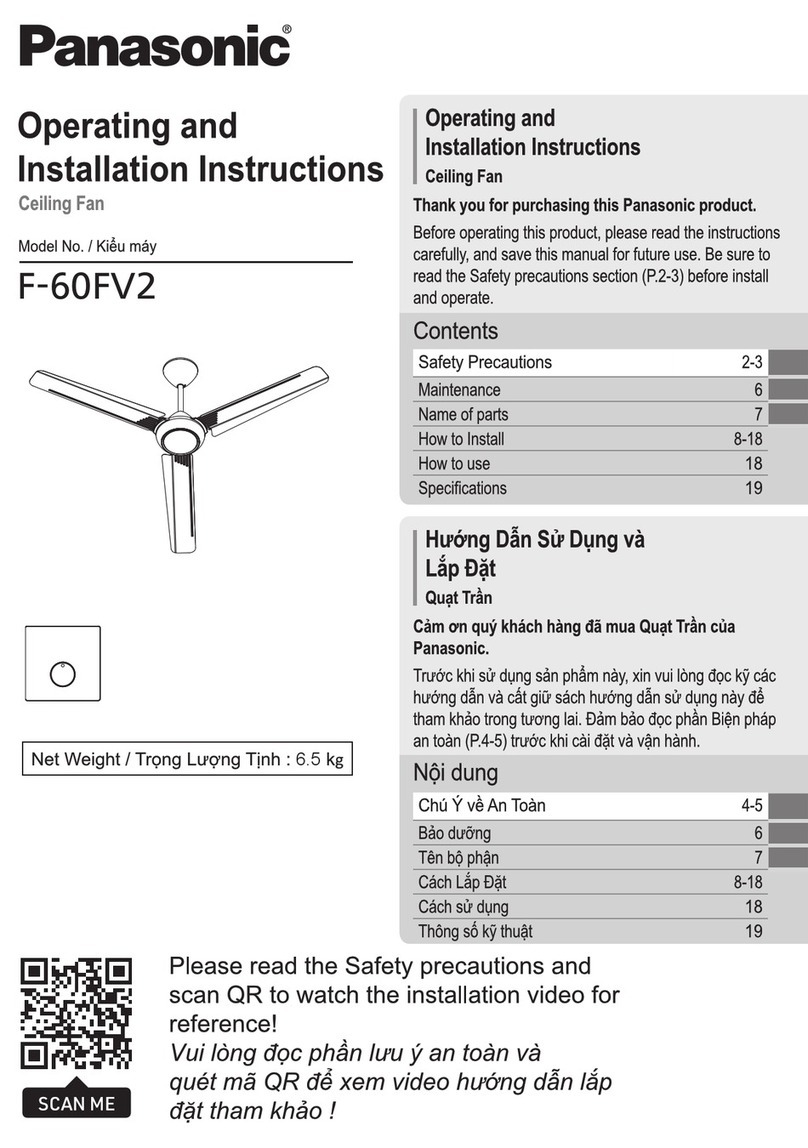
Panasonic
Panasonic F-60FV2 Operating and installation instructions
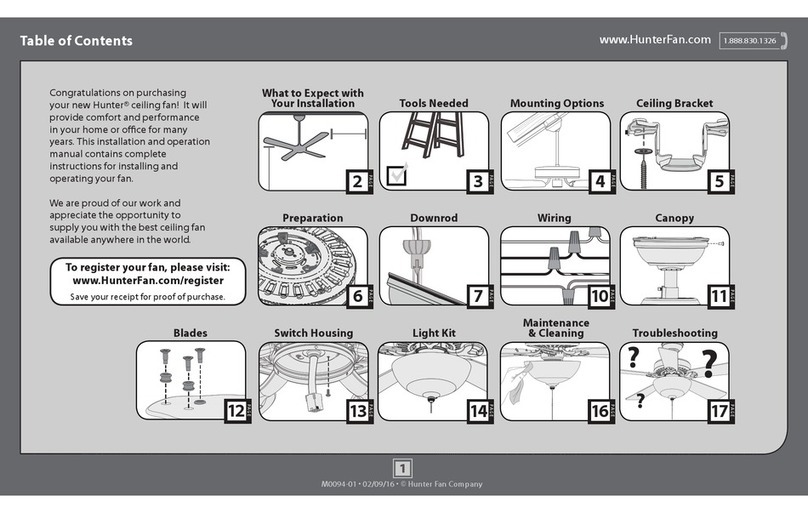
Hunter
Hunter M0094-01 instructions
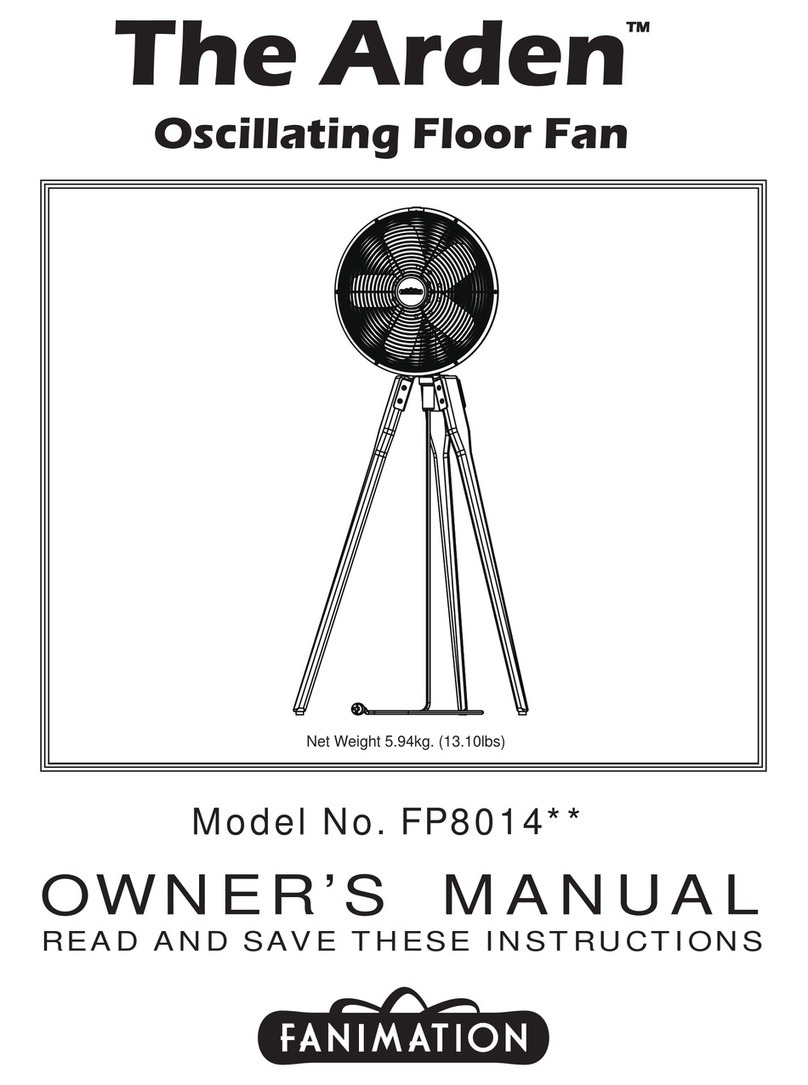
Fanimation
Fanimation FP8014 Series owner's manual
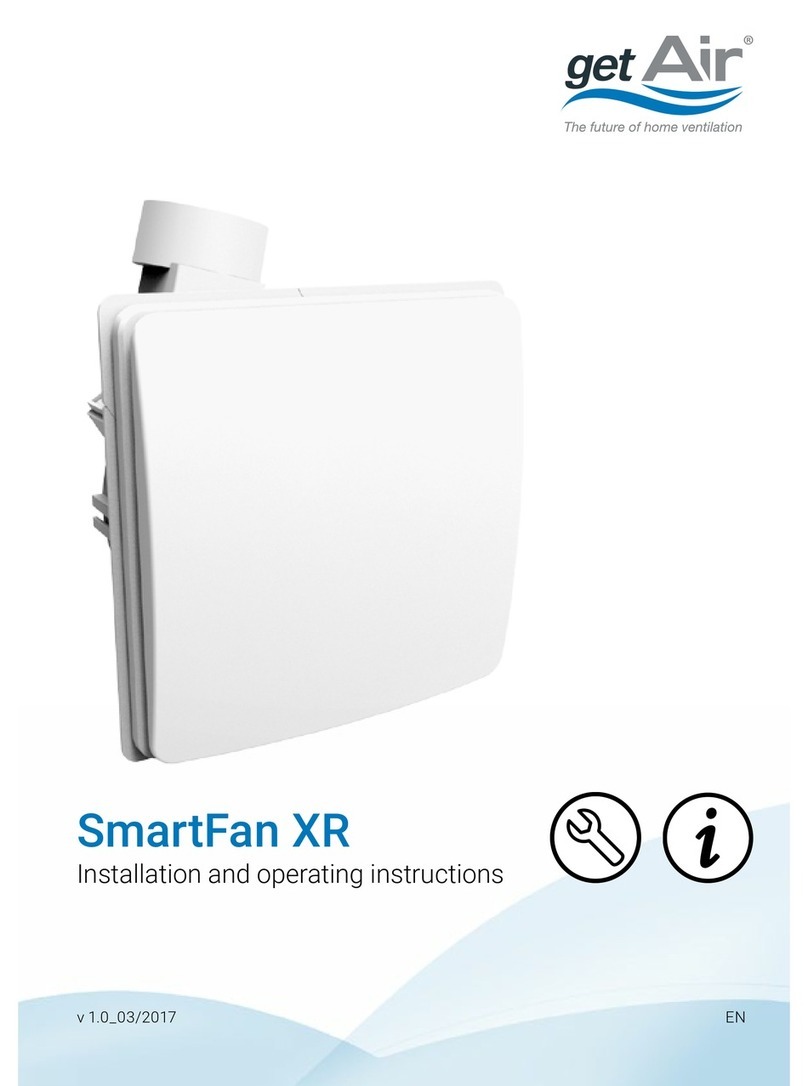
getAir
getAir SmartFan XR Installation and operating instructions

iLiving
iLiving ILG8SF301 owner's manual

AC Infinity
AC Infinity Airlift Series user manual
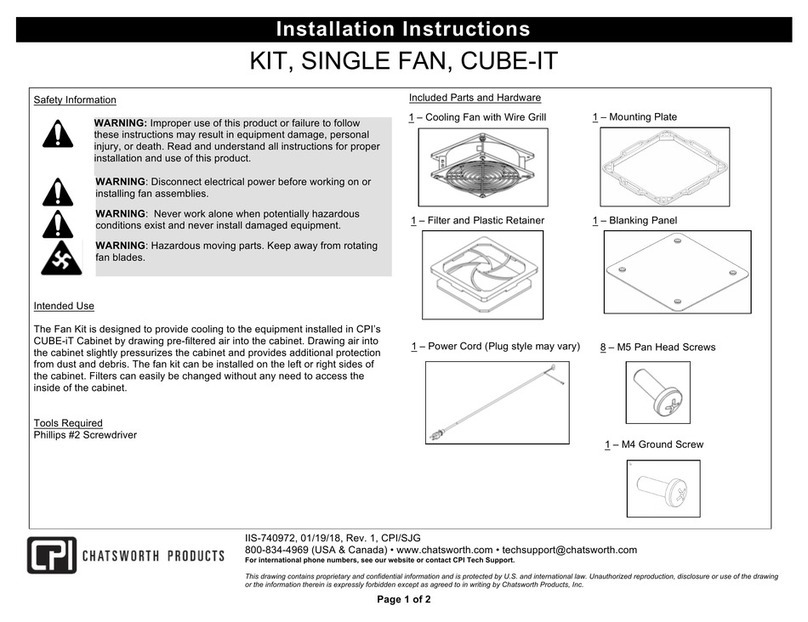
Chatsworth Products
Chatsworth Products 40972-001 installation instructions

Schuller
Schuller SIROCO installation guide

NuAire
NuAire SUNWARM TILE 1 Installation and Maintenance Details

Aspira
Aspira ECOCOMFORT 2.0 SMART Series Use and installation manual
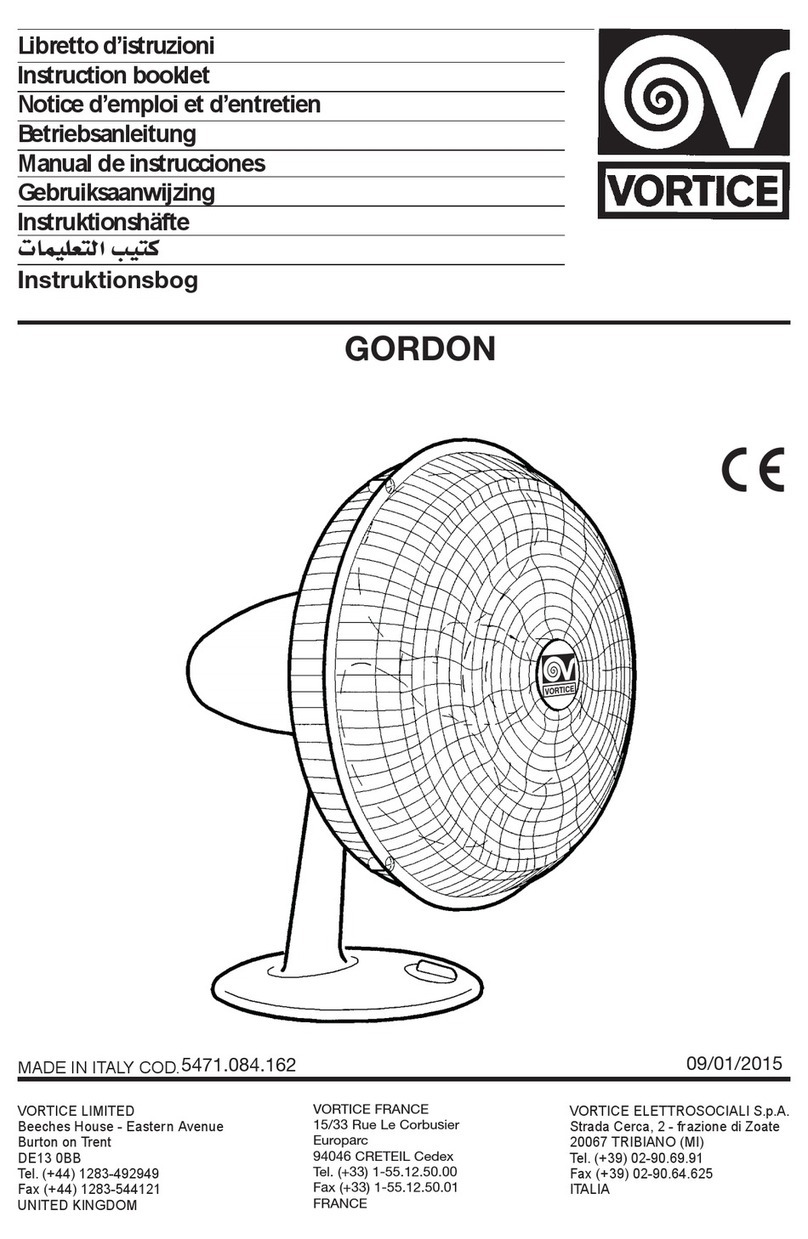
Vortice
Vortice GORDON Instruction booklet

Vento
Vento Ventomist VTHPMF-3010 manual
